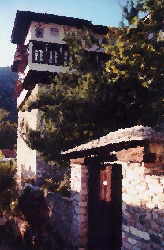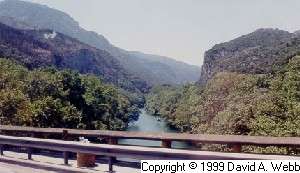

 Volos: A rather large city,
Volos has a terrific archaeological museum with some breathtaking examples
of Classical and Hellenistic jewelry. They are also constructing an
ancient house (prehistoric period) across the street and near the water front.
I do not know much about Volos right now, but I will try to get some more
information soon.
Volos: A rather large city,
Volos has a terrific archaeological museum with some breathtaking examples
of Classical and Hellenistic jewelry. They are also constructing an
ancient house (prehistoric period) across the street and near the water front.
I do not know much about Volos right now, but I will try to get some more
information soon.
The very long trip from Ioannina to Thessaloniki is only sparked by the passing through the Vale of Tempe, a strategic pass that has been hewn deep into the mountain by a river alongside the modern road. Extremely narrow at points, it was the major entrance between Macedonia and the south.
Once you've gone through the pass, you'll enter
Pieria
, the southernmost part of Macedonia. Another amazing site was
the castle of Platamon
on the edge of the sea (shortly after passing through Tempe where another
narrow passage is created). It was built by the crusaders in 1204 and
with the cloudy weather, sea, and general area, it is easy to forget you're
in Greece and not in England or  Ireland.
Ireland.
Dion: I did not stop at Dion on my first trip (negotiating a bus ticket from Ioannina to Dion would not have been my idea of a good day), but I did make it there on my second try. The archaeological site there is going to be one of the best facilities in all of Greece when they finish the construction. The accompanying guide book is top of the line. The museum even has a superb teaching classroom on the bottom floor that you should not miss. The site is spread out, but it is worth your time. The view back to Mount Olympos is also quite breathtaking. Here is a pasted together set of photos to give you a good idea of the view (the reconstructed theater is seen below the mountain range).
Mount Olympus: The whole mountain can be seen, but only in the best weather (I missed it entirely on my first trip, but the second time it was very clear). It is usually clouded at the top, but you are not supposed to be able to see the gods now are you?! If you want a good view of the mountain, you might need to take a look at this site with plenty of photos ( this one is even better!!). For a video of a hike to 2,000 feet up the mountain (47 seconds worth), try this link .
Salonika
Thessalonika: (400,000 inhab.) The second city of Greece is arrived at after passing through miles and miles of swampy areas and rice fields, but it sits on a narrow plain between the Thermaic Gulf and nearby mountains to the east. Thessalonika is not a very picturesque town, the bay was very choppy while I was there and wind was strong. The city was the "Cultural Capital of Europe for the year of 1997" and they (and country for that matter) were very proud of the designation. You can start your visit of Thessalonika with a visit to one of the numerous historic churches, of which quite a number are now represented online. Try the Church of Saint Demetrios . It was the one I visited while I was there and it was quite a sight, especially the Crypt of Saint Demetrios in the bottom of the building. If you really like the Byzantine sites, try any number of these: Church of Saint Panteleimon , Church of Prophet Elijah , Church of St. Nicholas Orphanos , The Church of Acheiropoietos , Church of Aghioi Apostoloi (the Holy Apostles) , Church of Our Lady of the Coppersmiths , Church of Aghia Sophia . There is also a Byzantine museum in The White Tower , which is the landmark of the city and is found on most Salonika motifs. Construction is still underway at the massive new Museum of Byzantine Civilization , but you can still visit part of the building, where exhibitions are open. There is also a site with panoramic views of Thessalonika .
If you prefer the Classical Greek, Hellenistic, or Roman periods, take heart, there's plenty to see here. First you can stop by the excellent Archaeological Museum of Thessalonika . It is the second best in the country behind the NAM in Athens. You can also walk around the theater and the Ancient Forum , currently under excavation, which is right in the heart of the city. You can't miss the city walls (well preserved), the huge Arch of Galerius , built in 305 A.D., and the Mausoleum of Galerian , once a church, then a mosque (with minaret), then a church, then a Byzantine museum, and now undergoing reconstruction after earthquakes in the 1970's. It's also known generally as the Rotunda.
Though I didn't make it to these sites, they are also very important archaeologically and are not far from Thessalonika:
Vergina: Vergina is the archaeological site where the royal tombs of Macedon were excavated in the late 1970's, yielding a treasure trove of items including the bones of Philip II, father of Alexander the Great. I do not want to get on anyone's hit-list, so I will just say that there is still a controversy going on between scholars and archaeologists over whether or not the tomb is really that of Philip II. I will also say that whether or not the tomb belongs to him, the site is still an absolutely must-see location. The museum is terrific and the jewelry, paintings, and other countless royal burial objects cannot be seen anywhere else in the entire world. Most of the items have been displayed at the Archaeological Museum of Thessalonika and then moved back to the museum at the site . This is yet another Greek site that has been designated as a World Heritage Site by UNESCO (1996). You can read about the site and Philip II from the primary sources, all online! The material has been gathered here . The site of the theater where Philip II was murdered and the large building built there possibly to celebrate the anniversary of his death are also good to stop by if you are in the area.
Pella
Pella: (2,272 inhab.) Catch the bus in Thessalonika early and head out to Pella, modern center of the praefecture of Pella , and the birthplace of Alexander the Great and served as the palace of Macedonia (read up on Alexander here). The uncovered remains at The Archaeological Site at Pella are not that large but some very nice villas have been found with amazing mosaics. (The picture here shows the modern town in the upper right portion of the screen. The site is the small, cleared out space almost halfway up the right side of the photo) The homes that are there now are extremely large and there is a fresh water system that runs under the street. There has been more discoveries a little distance from the site (possibly the palace on a small acropolis and some temples that are not ready for public viewing yet), but it will be a while till they are included with the site. My visit was cut a little short when a pack of hungry looking stray dogs started to wander towards me, the only person at the site. There is a nice Archaeological Museum of Pella across the highway with some of the mosaics. The town in the picture is about two kilometers from the site. The landscape is vastly different than most places in Greece. There are no hills for as far as you can see, just flat, good farmland.
During my first visit, I actually rode back to Thessalonika with a woman who stopped to pick up the other man at the bus stop and asked me "Salonika?" Maybe a little risky, but in my entire trip in Greece I never felt really threatened. But why would a thief want to try to take the bag away from a 6'4" college boy when there are countless old ladies with purses containing a lot more than my bag probably would. Also I might catch 'em. ;-)
Chalkidiki
Potidaea: The city of Potidaea was located near the narrowest point of the peninsula. It was an important classical city whose rebellion against Athens helped cause the Peloponnesian War. We visited the site in my second trip, but I do not have much information online about it yet.
Olynthos: Olynthos
is of special importance to me since the person who excavated it, David M.
Robinson, later donated much of his collection to the University of Mississippi.
You can see much of the collection online at the
David M. Robinson Collection
. The excavation of the
Archaeological Site of Olynthos
was important because it provided quite a lot of information to scholars
on the average Greek homes of the period (4th century B.C.) (the
Bouleterion
there was also found). It also provides a firm date for pottery styles
since almost the exact date of its destruction is known and no other habitation
at the site disturbed the material. At the online site, you can see
a
Mosaic of Bellerephon
. And on our site, you can see a scale
painting of the same mosaic
(along with several others from the site) by the German archaeologist Baron
von Peschke, who recreated many of the mosaics at Olynthos. There
is a small "museum" at the site with terrific displays, but they were just
finishing it when I visited the second time and there were no archaeological
objects there yet.